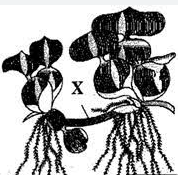
In the given figure of water hyacinth, a structure is marked “X”. This structure is involved in vegetative propagation as a unit of vegetative propagules. Identify the type of unit.

(A) Tuber
(B) Offsets
(C) Sucker
(D) Rhizome

Answer
320.7k+ views
Hint: Before we proceed into the problem, it is important to know the definition of Water Hyacinth.
The Water Hyacinth regulates its own growth through two mechanisms: passive diffusion (receiving dissolved nutrients from soil or groundwater) and active absorption of sunlight via photosynthesis. When released into fresh water resources, this plant forms thick mats that block out light and suffocate nearby aquatic lifeforms.
Complete Step by Step Answer:
In the provided figure, the specified structure is offset. In some aquatic species, offsets are lengthy runners with one internode. Propagation is aided by breaking offsets, as seen in Eichhornia (water hyacinth) and Pistia (Water lettuce).
Asexual plant reproduction known as vegetative propagation occurs when complex structures separate from the parent plant and grow into new individuals with the same genetic makeup as the parent plant.
For instance, liverworts and mosses create tiny tissue clumps called gemmae that are distributed by rainwater splashing to create new plants. In cultivars, tubers, runners, suckers, offsets, conns, rhizomes, and runners all play a significant role in vegetative reproduction and spreading.
Therefore, the type of unit is Offsets.
Hence, the option B is correct
Note: In order to grow, water hyacinth uses offsets. A short, thick runner, similar to a branch that bears a new plant at the end is called an offset. Offsets develop from the parent plant's stem in all sides. Aquatic plants like Pistia and Eichhornia have this kind of alteration.
The Water Hyacinth regulates its own growth through two mechanisms: passive diffusion (receiving dissolved nutrients from soil or groundwater) and active absorption of sunlight via photosynthesis. When released into fresh water resources, this plant forms thick mats that block out light and suffocate nearby aquatic lifeforms.
Complete Step by Step Answer:
In the provided figure, the specified structure is offset. In some aquatic species, offsets are lengthy runners with one internode. Propagation is aided by breaking offsets, as seen in Eichhornia (water hyacinth) and Pistia (Water lettuce).
Asexual plant reproduction known as vegetative propagation occurs when complex structures separate from the parent plant and grow into new individuals with the same genetic makeup as the parent plant.
For instance, liverworts and mosses create tiny tissue clumps called gemmae that are distributed by rainwater splashing to create new plants. In cultivars, tubers, runners, suckers, offsets, conns, rhizomes, and runners all play a significant role in vegetative reproduction and spreading.
Therefore, the type of unit is Offsets.
Hence, the option B is correct
Note: In order to grow, water hyacinth uses offsets. A short, thick runner, similar to a branch that bears a new plant at the end is called an offset. Offsets develop from the parent plant's stem in all sides. Aquatic plants like Pistia and Eichhornia have this kind of alteration.
Recently Updated Pages
Capping is a process in which A adenylate is added class 12 biology NEET_UG

Explain in brief the separation and isolation of DNA class 12 biology NEET_UG

Number of testicular lobules in testes is A 250 B 500 class 12 biology NEET_UG

Given diagram showing a typical agarose gel electrophoresis class 13 biology NEET_UG

Questions & Answers - Ask your doubts

A man running at a speed 5 ms is viewed in the side class 12 physics CBSE

Trending doubts
What is BLO What is the full form of BLO class 8 social science CBSE

Differentiate between an exothermic and an endothermic class 11 chemistry CBSE

Which places in India experience sunrise first and class 9 social science CBSE

The shortest day of the year in India

What are the major means of transport Explain each class 12 social science CBSE

Which are the Top 10 Largest Countries of the World?




